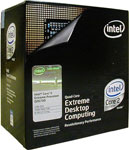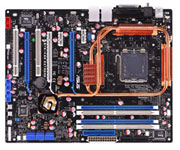High-End Buyers' Guide: May 2007
by Dave Robinet and Jarred Walton on May 29, 2007 1:30 AM EST- Posted in
- Guides
Ultra High-End Intel System
One of the most difficult decisions in this guide was choosing between the QX6700 processor and the Core 2 Extreme X6800. The X6800 is the absolute top-end gaming performer due to its slightly higher stock speed, but the additional two cores of the QX6700 will have a more substantial impact in encoding and other content creation applications. The prices between the two processors are virtually identical. Of course, if you're willing to spend even more money the QX6800 is now available (if you can find it in stock) with prices starting at around $1300 and a stock clock speed that matches the X6800 (2.93 GHz). In the end, the QX6700 gets the nod on the grounds that game and application developers are promising that multi-threading will get more attention in the future. We don't expect performance to double in anything but the most extreme cases; however, it will likely have a greater impact than the extra couple hundred megahertz in the X6800.
It's also important to remember that all of Intel's Core 2 Extreme processors have unlocked multipliers, so it's extremely easy to turn your QX6700 into a QX6800. QX6800 parts might have little bit more headroom when it comes to overclocking, but if all you're interested in is a good quad core overclocking chip we would probably take a step back to the Q6600 instead and save some money to invest in a better cooling solution and power supply. Needless to say, combining SLI with a heavily overclocked quad core processor can result in some serious power requirements. (Ed: And in the winter such computers can serve as great space heaters!)
Note that while both the QX6700 and X6800 processors cost roughly double what AMD's flagship FX-74 processor goes for, you need to purchase two FX-74 processors. Intel holds the overall performance crown, and users who want that performance will pay the price, plain and simple. Say it with us: competition is healthy for consumers.
On the subject of expensive components, the ASUS Striker Extreme is one of the highest-priced motherboards on the market today. At $307, users demand - and, fortunately, receive - the best quality and feature set of any comparable motherboard. As is the case with all of ASUS' current "Republic of Gamers" line, there is the diagnostic LCD panel, heat-piping, and SupremeFX audio. The 680i chipset ensures full x16 bandwidth to both graphics cards in an SLI configuration, and a third x16 slot is included which runs at x8 speed. An alternate motherboard selection (if you aren't going to run an SLI configuration) is the ASUS P5WDG2 WS Professional.
Two Crucial BL2KIT12864AA1065 kits bring the Intel system to 4GB of memory. Though clocked at unimpressive 5-5-5-15 timings, this RAM can typically be made to run substantially more aggressively with little effort. Even more impressive is the price - the kits can be had for $130 each (after the massive $85 mail-in rebate, that is).
The remaining components are the same as were chosen in the AMD Ultra High-End platform. The Intel system is almost always going to be faster than the current AMD Quad FX platform, as we showed in our Quad FX article, but the dual sockets and HyperTransport interconnects do allow the AMD platform to scale better in many situations when moving from dual core to quad core. Of course, the power requirements of Quad FX are also quite a bit higher than Intel's Core 2 Quad solutions.
The sweet spot in terms of price/performance for Intel lies in the "mainstream high-end" segment, while we start to see diminishing returns as we move upwards. With Intel's new P35 chipsets and Penryn processors making their introduction in the not-too-distant future, it may make sense to avoid the extreme high-end echelon of processors altogether at the moment.
| Ultra High-End Intel System | |||
| Hardware | Component | Price | Rebates |
| Processor | Core 2 Extreme QX6700 | $967 | - |
| Motherboard | ASUS Striker Extreme | $305 | - |
| Memory | 2 x Crucial Tracer Ballistix BL2KIT12864AA1065 (4x1GB) | $430 | $170 |
| Video Card | 2x MSI NX8800GTX-T2D768E-HD OC GeForce 8800GTX | $1140 | $40 |
| Hard Drive | WD Raptor WD1500ADFD plus WD 5000YS | $361 | - |
| Optical Drive | Pioneer DVR-212BK | $42 | - |
| Operating System | Windows Vista Home Premium 64-bit (OEM) | $125 | - |
| System Total | $3370 | $3160 | |
| Complete Package | $3906-$5565 | $3696-$5355 | |
 |
It's also important to remember that all of Intel's Core 2 Extreme processors have unlocked multipliers, so it's extremely easy to turn your QX6700 into a QX6800. QX6800 parts might have little bit more headroom when it comes to overclocking, but if all you're interested in is a good quad core overclocking chip we would probably take a step back to the Q6600 instead and save some money to invest in a better cooling solution and power supply. Needless to say, combining SLI with a heavily overclocked quad core processor can result in some serious power requirements. (Ed: And in the winter such computers can serve as great space heaters!)
Note that while both the QX6700 and X6800 processors cost roughly double what AMD's flagship FX-74 processor goes for, you need to purchase two FX-74 processors. Intel holds the overall performance crown, and users who want that performance will pay the price, plain and simple. Say it with us: competition is healthy for consumers.
 |
Two Crucial BL2KIT12864AA1065 kits bring the Intel system to 4GB of memory. Though clocked at unimpressive 5-5-5-15 timings, this RAM can typically be made to run substantially more aggressively with little effort. Even more impressive is the price - the kits can be had for $130 each (after the massive $85 mail-in rebate, that is).
The remaining components are the same as were chosen in the AMD Ultra High-End platform. The Intel system is almost always going to be faster than the current AMD Quad FX platform, as we showed in our Quad FX article, but the dual sockets and HyperTransport interconnects do allow the AMD platform to scale better in many situations when moving from dual core to quad core. Of course, the power requirements of Quad FX are also quite a bit higher than Intel's Core 2 Quad solutions.
The sweet spot in terms of price/performance for Intel lies in the "mainstream high-end" segment, while we start to see diminishing returns as we move upwards. With Intel's new P35 chipsets and Penryn processors making their introduction in the not-too-distant future, it may make sense to avoid the extreme high-end echelon of processors altogether at the moment.










69 Comments
View All Comments
JarredWalton - Tuesday, May 29, 2007 - link
Last I checked, they weren't readily available yet. Considering we explicitly mention this in the text on the first and last pages (as well as in-between), I'm pretty sure we've covered the situation. The official launch is next week, at which time all the websites respecting the launch date (Newegg and ZipZoomFly are usually the benchmark here) will start selling them. I'm not sure most of the sites listing the boards have them in stock and ready to ship today as it stands; if they can't be trusted to follow Intel's launch date, can their inventory claims be trusted?Latyshev - Tuesday, May 29, 2007 - link
Ah, sorry, i didnt read the article in detail, just looked over the major points. Thank you for clarification.Tuffrabbit - Tuesday, May 29, 2007 - link
Quote " Audigy users may get support in the future, but at present they are left out in the cold. "Man what a drag that Vista has been out now four months and still there are issues with sound cards, guess I'll wait some more before upgrading the operating system...
AnnihilatorX - Tuesday, May 29, 2007 - link
I don't see why the SLI GeForce GTS is not a good investment. The performance seen in many benchmarks definitely have 40% edge over a single Ultra. GTS 320MB SLI is also very affordable and have the aforementioned performance on resolutions less than 1900 while bearing more performance/$ than ultra/GTXTilmitt - Tuesday, May 29, 2007 - link
There's no point in including the operating system cost, most of us pirate it. And rightly so!punko - Tuesday, May 29, 2007 - link
Pirate? I don't think so.Dual boot machine: Linux/legit windows for work/play
If you're spending the money for a "high end" machine, there is no reason not to go fully legit.
JarredWalton - Tuesday, May 29, 2007 - link
Besides, if you're so cool that you can pirate the software, I'm sure you can handle doing a little bit of math to subtract the cost from the total. I have to say that anyone looking to stiff The Man by stealing $120-$200 of software on a $5000 system needs some counseling about what's important in life.Martimus - Tuesday, May 29, 2007 - link
Speak for yourself. I stopped pirating software once I got a real job. When I can't afford to buy the software, I just don't buy it now.yacoub - Tuesday, May 29, 2007 - link
On the concluding page is a list of soundcards (though very little is said about them).The Auzentech card has a name though: It's the X-Meridian 7.1 which you can see by going to their website. Not sure why you list it as "AZT-XM71" since I've never seen it listed that way except as the part number part of the heading at NewEgg.
http://www.auzentech.com/site/products/x-meridian....">http://www.auzentech.com/site/products/x-meridian....
http://www.newegg.com/Product/Product.aspx?Item=N8...">http://www.newegg.com/Product/Product.aspx?Item=N8...
I'm sure it's an awesome card, btw, as I have their X-Plosion DTS 7.1 card and love it. It's been flawless for me in gaming and offers excellence in sound reproduction for games, movies, mp3s, etc.
yacoub - Tuesday, May 29, 2007 - link
If you are buying two GTS 640MB, shouldn't the $30 rebate also be counted twice? (I'm looking at the first system.)